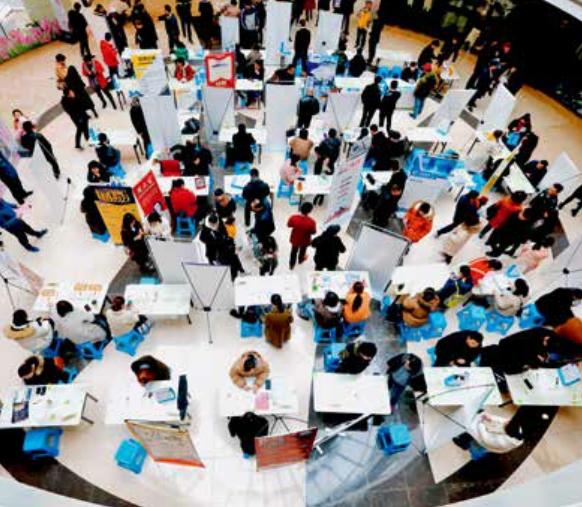Rising to the Challenge
2019-05-06byChinaPictorial
by China Pictorial
During the 2019 annual sessions of the National Peoples Congress and the National Committee of the Chinese Peoples Political Consultative Conference, popularly known as the “two sessions,” China stressed the complicated and challenging problems it faces in the domestic and international environment and the need to address issues in multiple fields to achieve highquality development.
In pursuing development in 2019, China has faced “a complicated and challenging domestic and international environment of a kind rarely seen in many years,” as Chinese Premier Li Keqiang pointed out in this years government work report.
Presently, Chinas economy is facing downward pressure. Meanwhile, China is also in the process of transitioning from high-speed to high-quality development. Economic factors are changing from traditional growth modes to a high-quality growth mode. This is an inevitable trend as the country replaces old growth drivers with new ones.
Jia Jinjing, assistant dean of the Chongyang Institute for Financial Studies at Renmin University of China, noted that in the structure of the world economy, China once led in accepting international industrial transfer, but the situation is different today. From the perspective of consumption, the countrys nearly 60 percent urbanization rate will help promote the upgrade of consumption demand and motivate high-quality development. From the perspective of regional development, the scale effects of economic development of regions such as the Beijing-TianjinHebei region, the GuangdongHong Kong-Macao Greater Bay Area and the Yangtze River Delta are emerging, and Chinas urban space and rural outlook are also being optimized and upgraded rapidly. From the perspective of driving forces, the contribution rate of scientific and technological progress to Chinas economic growth rose from 50.9 percent in 2010 to 58.5 percent in 2018. Chinas industrial development is now taking advantage of its technological innovation and scale effect to create new competitive edges.
But in the process of transitioning from high-speed to high-quality development, China still needs to address many problems. To rise to challenge, the country needs to focus on work in the following fields.
Reform of SOEs Must Accelerate
Chinas 2019 government work report mentioned “accelerating reform of state-invested enterprises and state-owned enterprises (SOEs).” Reform of Chinas SOEs began in 1978, but it recently entered a new phase as the countrys economic situation has changed dramatically.
Xu Feibiao, deputy director of the Center for BRICS and G20 Studies at China Institutes of Contemporary International Relations, believes that in the new era, only accelerating reform of SOEs will enable China to grapple with challenges at home and abroad. Based on the fruits of existing reform, it is necessary for China to establish a state-owned asset management system, a modern enterprise system, a market-oriented operational mechanism and a professional manager employment and training mechanism in line with contemporary professional standards to promote the countrys economic transformation and upgrading. China must have global vision and the initiative to meet the challenges of the changing international landscape, the new wave of globalization and the revolution in science and technology.
Employment: A New Priority Target for Chinas MacroControl Policies
For the first time, China has elevated employment-first policy to the status of macro policy in 2019. This is to increase societywide attention to employment and enhance support for it, indicating that the focus of Chinas macroeconomic regulation policies will shift to employment.
Professor Su Jian with the School of Economics at Peking University asserted that elevating employment to such an important position in this years government work report shines a spotlight on Chinas current severe employment situation, which is closely related to the transformation of the countrys labor market. Su believes that in the current macroeconomic situation, China could start with the following strategies to increase employment: First, the government should continue to cut taxes and administrative fees for enterprises. Second, Chinas industrial structure should be optimized to match the countrys current employment structure and avoid structural unemployment. Third, stabilizing the economy is the foundation for stabilizing employment, and stabilizing expectations should be highly prioritized. Fourth, unemployment benefits and relief should be universal to ensure social stability.
Opening to the West
“For many years, western China has neglected its geographical advantages in linking to countries and regions surrounding the Indian Ocean as well as landlocked countries across the Eurasian continent,” declared Dai Yonghong, professor at the Institute of South Asian Studies of Sichuan University. The years government work report demonstrates that China is determined to promote high-standard opening up. The country will open more sectors and improve the layout of opening up, while adopting new policies and measures to promote the development and opening up of the west part of the country.
Dai noted that western China is adjacent to countries and regions rich in resources in Central Asia, South Asia and Southeast Asia, and transport routes through the Indian Ocean can further connect it with West Asia, the Middle East and Africa. He believes that looking further west offers some ideal solutions for enhancing the opening up of western China.
For western China, further opening up also requires a shift from “passive” to “active” participation. Compared to coastal regions in the east, local governments in western China tend to act slowly in providing services, and local enterprises are often hesitant to expand business. Local governments should develop closer relationships with business enterprises, better help them understand overseas markets and inquire about their concerns. On the other side, entrepreneurs should actively seek out local governments to express their desires for international business and investment cooperation.
Preventing Pitfalls in Rural Work
As outlined in this years government work report, four major tasks presently compose Chinas work related to rural areas and agriculture: beating poverty with precision alleviation, improving agriculture(particularly grain production), taking solid steps to upgrade rural infrastructure and deepening comprehensive rural reforms.
Wang Xiaoyi, head of the Center for Rural Environmental Social Studies and a researcher with the Institute of Sociology at the Chinese Academy of Social Sciences, believes that the key to prioritizing rural and agricultural development and ensuring that the living standards of rural residents reach moderate prosperity in all respects is establishing long-term and stable mechanisms for development.
The importance of long-term mechanisms was first evidenced by poverty alleviation. Phenomena such as one-and-done projects and big construction without proper management have emerged from time to time. A long-term working mechanism minimizes detrimental engagement, but establishing long-term mechanisms requires supportive policies and measures. During the countrys rural revitalization process, new problems need to be addressed and new policies formulated, but even more importance should be placed on maintaining the existing effective policies and positive trends.
Public Support for Private Enterprises
In 2019, China aims to devote greater efforts to optimizing the environment for the development of the private economy and effectively alleviating difficulties faced by the real economy, especially those of private enterprises and small and micro businesses in accessing affordable financing, as highlighted by Chinese Premier Li Keqiang during this years two sessions.
Since 2008, private enterprises in China have been haunted by a “tide of bankruptcy.” Zhang Peili, an associate professor at the Institute of Chinas Economic Reform and Development and a research fellow with the Research Center of Chinas Private Enterprises at Renmin University of China, believes that Chinas economic development in transformation is the fundamental cause of difficulties faced by Chinese private enterprises.
Zhang predicted that during Chinas process of economic transformation, private enterprises would inevitably become more diversified. It is necessary to astutely determine which private enterprises should be eliminated from the market or moved to different regions or countries, which need to be reformed and upgraded, and which just need accelerated development. Considering the drastically different needs of private enterprises, targeted support should be used to boost their development and enhance policy effectiveness.
Strengthening Long-range Vision
During this years two sessions, China stressed that it is not deviating from its chosen path of reform and opening up and is now consciously pursuing the goal of achieving greater qualitative growth as opposed to merely quantitative growth.
Sudheendra Kulkarni, a Mumbai-based political and social commentator who served as an aide to former Indian Prime Minister Atal Bihari Vajpayee, asserted that Chinas two-pronged approach of ambitious pursuit of success in high-tech industries alongside deepening its commitment to modernizing traditional industries, small and micro enterprises, services sector, agriculture and the rural economy would be well worth studying for India. He also referenced the need for massive expansion and deepening of India-China economic cooperation and more mutually beneficial cooperation and partnership in many other fields. The commentator opined that China could become a force of stability and growth for the entire South Asian region, especially by pursuing some out-of-the-box strategies and measures to bring India and Pakistan closer and promoting peace and development in Afghanistan through an innovative regional cooperation mechanism.
Driving Economic Growth with Consumption
In 2018, consumption contributed 76.2 percent of Chinas economic growth, marking its fifth straight year as the top driving force. Consumption has become a major force for the countrys economic growth.
At present, Chinas exports are facing profound changes in the external environment, weaker demand and gloomy prospects for further expansion. In terms of investment, China has already passed the stage of developing heavy and chemical industries. Thus, structural adjustment is now the major task in the short and medium term, rather than promoting investment. This situation positions consumption in a lead role in driving Chinas economic growth for the long term.
Dong Chao, a research fellow with the Chinese Academy of International Trade and Economic Cooperation, believes that several methods could be adopted to promote Chinas consumption and further drive economic growth. First, efforts must be made to increase residents income. Second, supply-side structural reform should be strengthened. Third, investment in commodity circulation facilities should be increased. Fourth, the consumption environment should be further improved.
Trade: Going Steadily into the Future
Looking back at 2018, global trade tension, protectionism and unilateralism surged. The international trade and investment landscape and the rules and norms for multilateral trade and investment are shifting radically. Overall, a series of policies and initiatives from the United States have been the primary cause for stunting global economic growth and altering international economic and trade rules.
Nonetheless, Chinas foreign trade maintains enough flexibility and margin for adjustment. Despite the escalating China-U.S. trade friction in 2018, Chinas foreign trade still achieved remarkable results. In addition, Chinas foreign trade will gain momentum toward high-quality development and trade liberalization. There is also ample room for the adjustment of Chinas policies of stabilizing foreign trade, which can still be aligned with international economic and trade rules. Su Qingyi, an associate researcher and deputy head of the International Trade Department of the Institute of World Economics and Politics at the Chinese Academy of Social Sciences, noted that Chinas two sessions this year focused on two “improvements” in foreign trade: one is to promote stable and higher-quality growth in foreign trade and the other is to promote trade liberalization and facilitation. Reform of trade rules provides a rare opportunity for Chinas foreign trade development, but at the same time, presents many challenges. Active participation in the reform of global economic and trade rules is crucial for China to turn challenges into opportunities.
